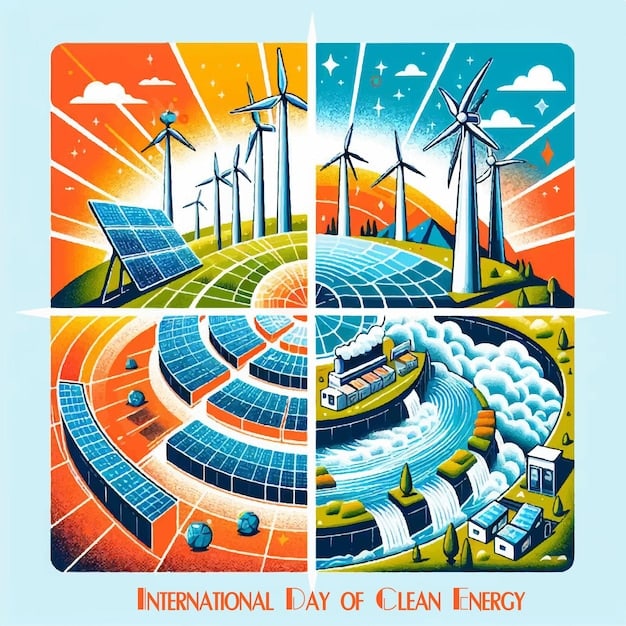Invest in Renewable Energy: A Guide to a Greener Future

Investing in renewable energy is a powerful approach to supporting a sustainable future, offering diverse opportunities from direct company stocks and ETFs to community projects and personal home upgrades, all while aligning financial growth with environmental stewardship in the transition to a low-carbon economy.
The global shift towards sustainability is undeniable, marked by a growing urgency to address climate change and reduce our reliance on fossil fuels. For individuals looking to make a tangible impact, understanding how to invest in renewable energy and support a greener future presents a compelling opportunity. This guide explores the myriad ways to channel your investments into sustainable technologies, offering not just financial prospects but also a stake in building a more environmentally friendly world.
Why invest in renewable energy?
Investing in renewable energy sectors signifies more than a financial decision; it’s a commitment to environmental stewardship and a belief in the future of sustainable development. This sector is not merely a fleeting trend but a fundamental shift in how we power our world, offering long-term growth potential and resilience against the volatility of traditional energy markets. The motivations for engaging in these investments are multifaceted, ranging from ethical considerations to robust financial returns.
Many investors are driven by the desire to align their portfolios with their values, choosing to support companies and projects that actively contribute to a healthier planet. This ethical component is increasingly important, particularly for younger generations of investors who prioritize social and environmental impact alongside financial gains. By directing capital towards renewable energy, individuals are directly fueling the innovation and expansion of technologies that combat climate change, reduce pollution, and foster energy independence.
Beyond the ethical imperative, the economic arguments for investing in renewables are becoming undeniably strong. Governments worldwide are implementing policies that favor clean energy, from tax incentives and subsidies to carbon pricing mechanisms, creating a fertile ground for growth. Technological advancements continue to drive down the cost of renewable energy production, making it increasingly competitive, and often cheaper, than fossil fuels. This cost advantage, combined with growing consumer demand for sustainable products and services, positions renewable energy as a key growth engine for the coming decades. Moreover, investing in this sector can offer a hedge against the geopolitical risks associated with fossil fuel dependence and the potential for stranded assets as the global economy decarbonizes.
Understanding the renewable energy landscape
The renewable energy landscape is vast and continually evolving, encompassing a range of technologies and services designed to harness natural, inexhaustible resources. Familiarizing oneself with its various facets is crucial for making informed investment decisions. This broad sector extends beyond just solar panels and wind turbines, incorporating a diverse array of innovative solutions that collectively contribute to a sustainable energy future.
At its core, the landscape is dominated by established technologies such as solar photovoltaic (PV) systems and wind farms, which have seen rapid advancements and cost reductions, making them highly competitive. Solar energy harnesses the sun’s power, while wind energy converts kinetic energy from wind into electricity. These two pillars form a significant portion of current renewable energy generation capacity and are often the most accessible entry points for investors due to their mature markets and established infrastructure.
However, the field also includes hydro-power, geothermal energy, and bioenergy. Hydro-power, utilizing the force of moving water, is a long-standing source of renewable electricity. Geothermal energy taps into the Earth’s internal heat, offering a constant and reliable power source in specific regions. Bioenergy, derived from organic matter, can be used to produce electricity, heat, or biofuels. Furthermore, emerging technologies like green hydrogen, advanced battery storage solutions, and tidal power are attracting significant investment and hold immense potential for future growth, promising to further diversify the renewable energy mix and enhance grid stability. Understanding these different technologies and their market dynamics is essential for identifying promising investment opportunities tailored to individual risk appetites and financial goals.

Direct stock investments in renewable energy companies
One of the most straightforward ways to invest in renewable energy is by purchasing shares of publicly traded companies directly involved in the sector. This approach offers investors direct exposure to the growth and innovation within individual companies, spanning across the entire value chain of renewable energy. However, it requires careful research and understanding of market dynamics.
These companies can range from those that design and manufacture solar panels, wind turbines, or energy storage solutions, to those that develop, own, and operate large-scale renewable energy projects. Examples include manufacturers of green technology components, utilities that primarily generate power from renewable sources, and companies specializing in energy efficiency or smart grid solutions. Investing in individual stocks allows for targeted exposure to specific segments of the market that an investor believes will outperform.
When considering direct stock investments, it is vital to conduct thorough due diligence. This involves analyzing a company’s financial health, competitive landscape, growth prospects, and management team. Look for companies with strong balance sheets, a clear strategic vision, patented technologies, and a proven track record of successful project execution. Diversification across several companies and different segments of the renewable energy market can help mitigate risk associated with the performance of any single stock. Investors should also stay informed about policy developments and technological advancements, as these can significantly impact the profitability and outlook of renewable energy firms.
ETFs and mutual funds: diversified approach
For investors seeking diversification and professional management without the need to select individual stocks, Exchange Traded Funds (ETFs) and mutual funds focused on renewable energy offer an excellent solution. These investment vehicles pool money from multiple investors to purchase a basket of stocks, providing exposure to a broad cross-section of the renewable energy sector. This approach inherently reduces risk compared to investing in single stocks, as the performance of one company will have a limited impact on the overall fund.
Renewable energy ETFs typically track an index composed of companies actively involved in various clean energy sub-sectors, such as solar, wind, hydro, geothermal, and electric vehicle infrastructure. Mutual funds, on the other hand, are actively managed by fund managers who make investment decisions based on the fund’s specific objectives and strategy. Both options provide immediate diversification across multiple companies, types of renewable energy, and sometimes even different geographical regions, which can be particularly beneficial in a rapidly evolving market like clean energy.
- Reduced Risk: Spreads investment across numerous companies, mitigating the impact of poor performance by any single entity.
- Accessibility: Offers an easy entry point for retail investors to participate in the renewable energy market without extensive research into individual stocks.
- Professional Management: Funds are managed by experts who continuously monitor the market and adjust holdings.
- Liquidity: ETFs can be bought and sold throughout the trading day, similar to stocks, providing flexibility.
Choosing between an ETF and a mutual fund often depends on factors such as management fees, investment objectives, and whether an active or passive investment strategy is preferred. Investors should carefully review the fund’s holdings, expense ratios, and historical performance to ensure it aligns with their financial goals and risk tolerance. This diversified approach makes investing in renewable energy more accessible and less daunting for many.
Private equity and venture capital opportunities
Beyond publicly traded stocks, a more advanced investment avenue into renewable energy exists through private equity and venture capital. These options involve investing in privately held companies or projects, often in their early stages of development. While offering the potential for higher returns, they also come with increased risk, illiquidity, and typically require a higher minimum investment, making them more suitable for sophisticated or institutional investors.
Venture capital funds often focus on nascent companies that are developing groundbreaking renewable energy technologies or innovative business models. These could include startups working on advanced battery storage, novel materials for solar cells, or sophisticated grid management software. The investment horizon for venture capital is usually long-term, anticipating that some of these companies will eventually achieve significant growth or be acquired, leading to substantial returns for the early investors.
Private equity, on the other hand, might target more mature privately held renewable energy projects or companies that require significant capital for expansion, infrastructure development, or acquisitions. This could involve funding the construction of a new wind farm, a utility-scale solar plant, or acquiring existing renewable energy assets. These investments often provide a pathway to influencing the actual deployment and scaling of renewable energy infrastructure. Due to the high risk and extended lock-up periods associated with private investments, thorough due diligence, including an understanding of the technology, market, regulatory environment, and exit strategies, is paramount. Access to these opportunities is typically through specialized funds or direct investments for accredited investors.
Community and direct project investments
For those looking for a more direct and localized impact, community renewable energy projects and direct financing options offer compelling alternatives to traditional market investments. These approaches allow individuals to invest directly in the deployment of renewable energy, often within their own communities, fostering a deeper connection to the environmental and economic benefits. This segment of investment often appeals to those who prioritize tangible outcomes and local economic development.
Community solar projects, for example, enable multiple subscribers to benefit from a single, larger solar installation located off-site. Participants can often purchase individual panels or subscribe to a portion of the project’s energy output, receiving credits on their electricity bills equivalent to their share of the power generated. This model makes solar energy accessible to those who cannot install panels on their own property due due to unsuitable roofs, shading, or rental agreements. It strengthens local renewable energy generation and can foster a sense of collective environmental responsibility.
Another avenue is direct investment in local renewable energy cooperatives or specific projects through crowdfunding platforms specializing in green initiatives. These platforms connect investors with developers seeking capital for projects like small-scale wind turbines, biomass facilities, or energy efficiency upgrades for public buildings. Such investments not only provide a financial return but also a clear stake in local energy independence and carbon reduction. These options, while potentially offering lower liquidity than publicly traded assets, provide a powerful way for individuals to fund real-world clean energy infrastructure and experience the direct impact of their capital.
Investing in your home: personal renewable energy solutions
One of the most immediate and tangible ways to invest in renewable energy and support a greener future is by implementing personal solutions within your own home. This approach not only reduces your carbon footprint and reliance on the grid but can also lead to significant long-term financial savings. For many, transforming their residence into a more sustainable dwelling is a practical as well as an ethical investment.
The most common starting point is the installation of rooftop solar panels. These systems convert sunlight directly into electricity, which can power your home, reduce or even eliminate your monthly electricity bills, and potentially feed excess power back into the grid through net metering programs. The declining cost of solar technology, coupled with federal tax credits (like the Investment Tax Credit in the US) and various state and local incentives, makes solar energy increasingly affordable and a sound investment.
Beyond solar, other home-based renewable energy solutions include geothermal heating and cooling systems, which use the stable temperature of the earth to provide efficient climate control, and household-scale wind turbines for those in suitable, windy locations. Investing in energy efficiency alongside renewable installations further maximizes impact. This includes upgrades such as improved insulation, energy-efficient windows and appliances, and smart home thermostats. These improvements reduce overall energy consumption, thereby lowering the amount of renewable energy needed to power the home and accelerating the return on investment.
- Solar Panels: Reduce electricity bills and carbon footprint; eligible for tax credits and incentives.
- Geothermal Systems: Highly efficient heating and cooling, leveraging stable ground temperatures.
- Energy Efficiency Upgrades: Complement renewable installations by reducing overall energy demand.
Each of these home improvements not only contributes to a greener future but also increases the value of your property and offers a degree of energy independence. Careful research into localized incentives and reputable installers is crucial to maximizing the benefits of these personal renewable energy investments.

Navigating risks and maximizing returns
Investing in any sector, including renewable energy, comes with inherent risks that must be carefully managed. While the long-term outlook for clean energy is overwhelmingly positive, understanding and mitigating potential downsides is crucial for maximizing returns. A thoughtful approach to risk management involves diversification, continuous education, and a clear understanding of market dynamics.
One primary risk in renewable energy investments relates to policy changes. Government incentives, subsidies, and regulatory frameworks play a significant role in the profitability and growth of certain technologies. Abrupt changes in these policies can impact project viability and company valuations. Technological risks are also present; while innovation drives progress, it can also render existing technologies obsolete or less competitive. Investors should therefore favor companies with robust research and development pipelines and adaptive business models.
Market volatility, interest rate fluctuations, and supply chain disruptions are other factors that can affect renewable energy investments, similar to broader market trends. Geopolitical events can also influence the supply and pricing of raw materials critical for manufacturing renewable energy components. To navigate these risks, investors should consider a diversified portfolio that spreads investments across different types of renewable energy technologies, geographical regions, and investment vehicles (e.g., combining direct stocks with ETFs). Staying informed about industry news, policy shifts, and global economic indicators is essential for making timely and informed decisions. Regular review and rebalancing of your portfolio can help ensure it remains aligned with your risk tolerance and financial objectives.
The future of renewable energy investments
The trajectory for renewable energy investments points towards continued, robust growth, fueled by global decarbonization efforts, technological breakthroughs, and increasing public and private sector commitments to sustainability. The future landscape will likely feature even greater integration of diverse energy sources, sophisticated grid management, and innovative financial instruments designed to accelerate the transition to a clean energy economy. This presents an exciting, dynamic environment for investors seeking both financial returns and positive environmental impact.
A key trend on the horizon is the continued decline in the cost of renewable energy generation, making it the most economical option in an increasing number of regions. This cost advantage will further accelerate adoption, driving demand for innovative solutions in energy storage, grid modernization, and smart energy management systems. Furthermore, the growth of green hydrogen as a versatile energy carrier is expected to open up new investment frontiers, particularly in hard-to-decarbonize sectors like heavy industry and long-haul transportation.
We will also see an expansion of sustainable finance products, making it easier for a broader range of investors to participate. This includes not just more diversified ETFs and mutual funds, but also green bonds, impact investment funds, and platforms for direct community project financing. The increasing focus on ESG (Environmental, Social, and Governance) criteria within mainstream investing will continue to channel significant capital into renewable energy and related sectors. As regulatory frameworks evolve to support cleaner energy and carbon reduction targets become more ambitious, the opportunities for investing in renewable energy will only multiply, solidifying its role as a cornerstone of sustainable economic growth.
| Key Aspect | Brief Description |
|---|---|
| 🌱 Diversified Investments | Explore stocks, ETFs, mutual funds, and private equity for varied exposure in renewable energy. |
| 🏡 Personal Solutions | Invest in home solar or geothermal to reduce bills and carbon footprint. |
| 🤝 Community Projects | Support local solar farms or crowdfunded green initiatives for direct impact. |
| 📈 Future Growth | Anticipate continued strong growth in renewables due to policy and tech advancements. |
Frequently asked questions about renewable energy investment
You can invest in various renewable energy types, including solar, wind, hydropower, geothermal, and bioenergy. Each has distinct characteristics and market dynamics, offering diverse opportunities across different technologies and geographical regions, from established utilities to innovative startups.
Direct stock investment offers targeted exposure to specific companies and potentially higher returns with higher risk. ETFs provide instant diversification across the sector, reducing individual stock risk, and are better suited for investors seeking broader market exposure and lower management burden. Your choice depends on your risk tolerance and research comfort.
Key risks include changes in government policy (e.g., subsidies, tax credits), technological obsolescence, market volatility, and supply chain disruptions. Geopolitical factors and fluctuating raw material costs can also impact profitability. Diversification and staying informed are crucial for managing these risks effectively.
Beyond the stock market, you can invest in personal solutions like rooftop solar panels or geothermal heating for your home. You can also participate in community solar projects, invest in local renewable energy cooperatives, or fund projects through specialized crowdfunding platforms, directly contributing to green infrastructure.
The long-term outlook for renewable energy investments is highly positive. Driven by decreasing costs, global decarbonization goals, and increasing commitment from governments and corporations, the sector is poised for continued robust growth, offering sustainable returns and significant environmental impact over the coming decades.
Conclusion
Embracing renewable energy investments is a powerful step towards building a more sustainable and resilient future. Whether through diversified funds, strategic stock picks, direct project financing, or personal home improvements, the opportunities to align financial goals with environmental stewardship are abundant. As the world accelerates its transition to a low-carbon economy, those who proactively invest in renewable energy are not just securing potential financial growth; they are actively participating in the essential global effort to combat climate change, foster energy independence, and pave the way for a greener planet for generations to come.





